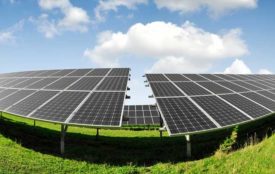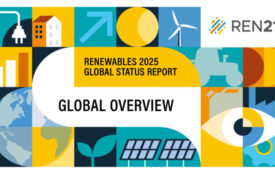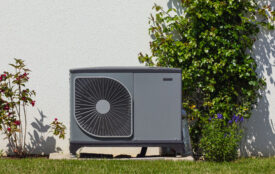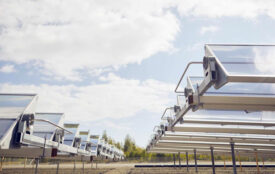Climate change: More algae and fewer aquatic plants promote methane emissions
In recent years, submerged macrophytes have disappeared in many shallow lakes around the world, with more algae and free-floating plants growing instead.
A Chinese team, in collaboration with IGB researcher Sabine Hilt, has shown in a large mesocosm experiment how heat waves, nutrients and pesticides promote algae growth and cause aquatic plants to dwindle. This shift in plant types may increase the total amount of greenhouse gas emissions from shallow lakes, as Sabine Hilt and Dutch colleagues demonstrated in another mesocosm experiment.
Granted, submerged aquatic plants may interfere with swimming, but they are important habitats for a wide variety of creatures and contribute to the self-purification of water bodies. If they are lost and algae and free-floating plants spread in water bodies instead, more greenhouse gases are also released. This is shown by a study in which IGB researcher Sabine Hilt was involved.
The scientist is investigating why many bodies of water have grown fewer submerged aquatic plants in recent years. “It is known that both the growth of algae and the turbidity of the water play an important role in this. After all, the plants, which are anchored with their roots in the sediment, need sunlight down there for photosynthesis, but other stressors also play a role,” Sabine Hilt explained.
Heat waves pose risks to aquatic plant populations in agricultural areas
Together with a team led by the Chinese Academy of Sciences in Wuhan, the IGB scientist investigated how typical stressors in agricultural landscapes – warming, nutrients and the pesticide glyphosate – affect the growth of algae and two aquatic plant species, individually and in combination. As examples, the researchers chose waterthyme (Hydrilla verticillata), which forms a canopy at the water surface, and vallisneria (Vallisneria denseserrulata), which grows at the bottom of the water body. To simulate shallow lakes, they used 48 mesocosms, each with a water volume of 2,500 liters.
In the experiment, warming or heat waves alone had no effect on the presence of algae, but reduced the biomass of vallisneria growing on the bottom. Increased nutrient concentrations increased algal growth and thus shading of both aquatic plants, especially vallisneria. The pesticide glyphosate alone had no effect on algal or aquatic plant growth when ambient temperatures were stable. However, heat waves promoted algal growth more than continuous warming when nutrients and glyphosate were combined. As a result, groundnettle biomass was lowest under these conditions.
“Our study showed that multiple stressors can interact to cause a loss of macrophytes. The risk of aquatic plants disappearing increases especially due to more frequent heat waves as a result of climate change in shallow water bodies in agricultural landscapes,” Sabine Hilt summarized.
Shift in plant types in water bodies leads to higher methane emissions
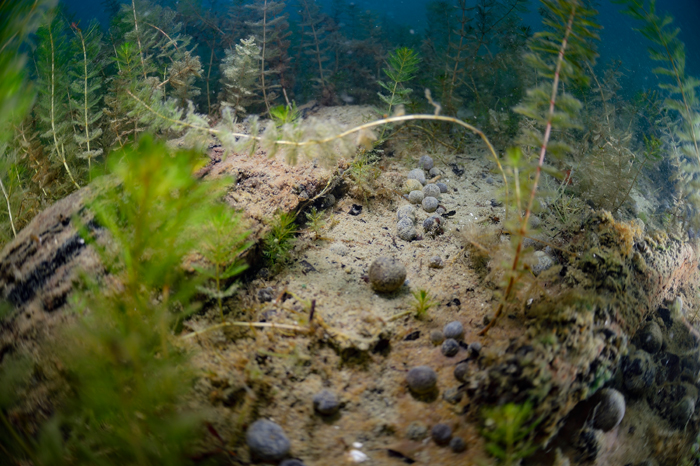
Such a shift in dominant plant types in water bodies can also lead to more greenhouse gases being released. This is shown by another mesocosm experiment in which Sabine Hilt was involved. The research team, led by Nijmegen University and the Netherlands Institute of Ecology (NIOO) in Wageningen, studied the effect of a 4°C warming on the release of greenhouse gases from mesocosms dominated by submerged plants, free-floating plants or algae for three consecutive years. The effect of warming on methane release was significantly higher in mesocosms dominated by free-floating plants and algae than in mesocosms where submerged plants grew predominantly. “One reason for lower methane emissions in waters with many underwater plants is certainly the formation of oxygen by the roots. In this way, the methane produced at the bottom of the water is oxidized before it can be released into the atmosphere,” Sabine Hilt explained.
The expected shift in aquatic plant type toward a dominance of algae or free-floating plants under climate change will certainly increase the total amount of greenhouse gas emissions from shallow waters – a previously overlooked feedback that continues to drive climate change. “Management strategies that aim to favor the occurrence of submerged aquatic plants can therefore help reduce greenhouse gas emissions from water bodies,” said Sabine Hilt.
- Read the article in Environment International, the second article was published in Water Research
- „Heat waves rather than continuous warming exacerbate impacts of nutrient loading and herbicides on aquatic ecosystems“ | Environment international. – 168(2022), Art. 107478
- Outlines | IGB Fact Sheet: Massenentwicklungen von Wasserpflanzen | german
QUELLE
Leibniz-Institut für Gewässerökologie und Binnenfischerei (IGB) 2022

